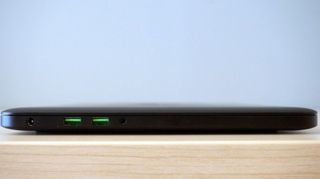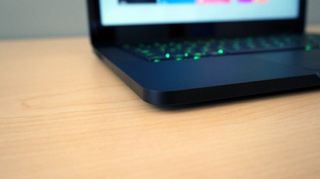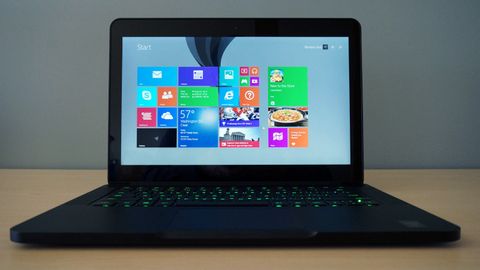Why you can trust TechRadar
It's already been said that the new Razer Blade is almost impossibly thin and light for a gaming laptop. But what do the numbers look like, and how does the new hotness compare with last year's model?
The new Blade measures a super slim 13.6 x 9.3 x 0.7 inches (W x D x H) and weighs just 4.47 pounds – just four tenths of an inch thicker and three tenths of a pound heavier. That's quite the feat for all the new, beefier hardware (and touchscreen) that Razer managed to cram inside this time around.
Now, let's put that into perspective. The 15.6-inch MSI GS60 Ghost Pro 3K measures 16.5 x 11.3 x 0.85 inches and hits the scale at 4.36 pounds. A bit thicker, sure, but much lighter, considering its larger dimensions. The Gigabyte P35W v2 tells a similar story, measuring just a tad thicker at 15.16 x 10.63 x 0.83 inches and weighing a heftier 5.07 pounds – but not by much, again considering its size in comparison.

But there's a likely explanation for all this: the Razer Blade is encased in an aluminum unibody enclosure, much like the MacBook Pro 13-inch with Retina display that it looks to emulate. I'm no expert in metals, but I'd venture to guess that aluminum, while a softer metal, is much more dense than the plastic used to cover the undersides of MSI and Gigabyte's gaming laptops.
For the most premium products, you pay by the pound – literally. At any rate let's take a closer look at what Razer managed to stuff inside 0.7 inches worth of alluring aluminum. Here is the Razer Blade configuration given to TechRadar:
Spec sheet
- CPU: 2.2 GHz Intel Core i7-4702HQ (quad-core, 6MB cache, up to 3.2GHz with Turbo Boost)
- Graphics: Nvidia GeForce GTX 870M (3GB GDDR5 VRAM), Intel HD Graphics 4600
- RAM: 8GB DDR3L (1600MHz)
- Screen: 14.0-inch, 3,200 x 1,800 (QHD+) IGZO, IPS with LED backlight, capacitive multi-touch
- Storage: 256GB SSD
- Ports: 3 x USB 3.0 port, HDMI 1.4, 3.5mm headphone/mic jack, security lock slot
- Connectivity: Intel Wireless-AC 7260HMW (802.11a/b/g/n/ac), Bluetooth 4.0
- Camera: 2MP HD webcam
- Weight: 4.47 pounds (2.02 kg)
- Size: 13.6 x 9.3 x 0.7 inches (W x D x H)
All of those top-end components crammed inside the most gorgeous chassis to ever grace mobile PC gaming is going to go for top dollar. The asking for this setup: $2,399 (£2,299, about AU$2,765), and shifting the configuration won't save you much money. Between the three available Razer Blade models, all that changes is the solid-state drive capacity.

If you're OK with a paltry 128GB of space, you'll save a measly $200. Want more space? Be ready to fork up an additional 300 smackers. This story is nothing new to consumer tech: if you want the thinnest, chicest and snappiest around, you better pay up. The question here I ask is, when it comes to gaming laptops, how much should that really matter?
Take two of the Blade's competitors, for instance. The most expensive version of the GS60 Ghost Pro 3K offers double the video memory from the same GPU, a larger screen (albeit at a slightly lower pixel count), a faster processor, double the RAM, more ports and gobs more storage – two 128GB SSDS and a 1TB, 7,200 rpm hard drive – for the same as the cheapest available Razer Blade. That said, it's not as much of a looker, though it's still quite nice.
Gigabyte offers a similar deal. You'll net a larger (though only FHD) IPS screen, a better version of the same graphics chip, a stronger CPU, double the memory, tons more space (a 256GB SSD and 1TB, 7,200 rpm HDD), and far more ports for $400 less than the cheapest Blade on Amazon. And though you will lose AC Wi-Fi for those savings, you'll gain a Blu-ray disc drive that can become an additional storage bay.

One thing in common that these two competing systems share is that they lack touchscreens. MSI and Gigabyte clearly made a call that such technology doesn't do much for PC gamers. Frankly, I wish that Razer would follow suit – it would at least shave a few bucks off the premium price tag.
Of course, none of this is to say that the Blade doesn't ... cut it when it comes to gaming. (Cue David Caruso.) Au contraire, as you'll soon see.
Joe Osborne is the Senior Technology Editor at Insider Inc. His role is to leads the technology coverage team for the Business Insider Shopping team, facilitating expert reviews, comprehensive buying guides, snap deals news and more. Previously, Joe was TechRadar's US computing editor, leading reviews of everything from gaming PCs to internal components and accessories. In his spare time, Joe is a renowned Dungeons and Dragons dungeon master – and arguably the nicest man in tech.


